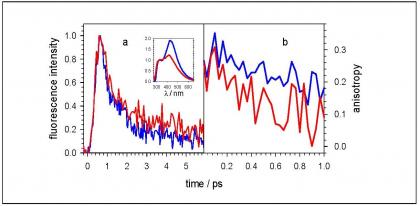

Polymeric and oligomeric DNA helices, poly(dAdT)·poly(dAdT) and (dAdT)10·(dAdT)10, composed of 200–400 and 20 adenine–thymine base pairs, respectively, are studied by fluorescence upconversion. Fluorescence decays, anisotropy decays and time-resolved spectra, obtained for this alternating base sequence, are compared with those determined previously for the homopolymeric sequence (dA)n·(dT)n. It is shown that identical fluorescence decays may correspond to quite different anisotropy decays and vice versa, both varying with the emission wavelength, the base sequence and the duplex size. Our observations cannot be explained in terms of monomer and excimer emission exclusively, as concluded in the past on the basis of steady-state measurements. Excitons also contribute to the fluorescence. These are rapidly trapped by excimers, characterized by long-lived weak emission.
Fluorescence of the DNA double helices (dAdT)n. (dAdT)n studied by femtosecond spectroscopy
D. Onidas, T. Gustavsson, E. Lazzarotto and D. Markovitsi, Phys. Chem. Chem. Phys. 9 (2007) 5143.
•  Physique et chimie pour le vivant et l’environnement › Physique et vivant / Physics and life
Physique et chimie pour le vivant et l’environnement › Physique et vivant / Physics and life
• Service des Photons Atomes et Molécules • Service des Photons Atomes et Molécules











